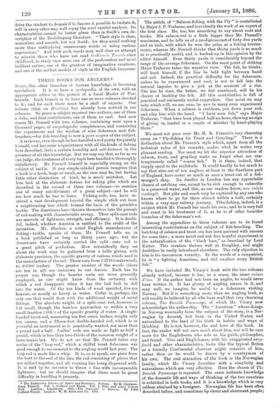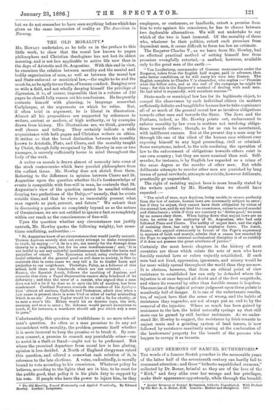THREE BOOKS FOR ANGLERS.* SPORT, like other branches of human
knowledge, is becoming specialised. It is to have a cyclopredia of its own, with an appropriate editor in the person of a ducal Maiter of Fox- hounds. Each branch is to have one or more volumes devoted to it ; and for each there must be a staff of experts. One volume (that on Hunting) has already been noticed in our columns. So grave a subject required two authors, one of them a duke, and four contributors, one of them an earl. And now comes Mr. Pennell with two volumes, containing near upon a thousand pages, of encyclopmdic completeness, and containing the experiences and the wisdom of nine fishermen and fish- breeders,—for fish-breeding is now a pars magna of the subject.
A reviewer, even though he has handled a rod pretty frequently himself, and has some acquaintance with all the kinds of fishing here described, feels a certain humility and self-distrust in the presence of all this knowledge. But we may say that, as far as we can judge, the treatment of every topic here handled is thoroughly satisfactory. Mr. Pennell himself is especially strong on the subject of tackle. If any simple-minded person imagines that a hook is a hook, large or small, as the case may be, but having little other distinction of kind, he is much mistaken. Let him look at the elaborate devices for taking pike which are described in the second of these two volumes—to mention one of many sub-divisions of a great subject—and he will see how much he has to learn. Fishing-rods, too, have re- ceived a vast development beyond the simple stick cut from a neighbouring tree which formed the basis of the primitive tackle. The Americans have thrown themselves into the pursuit of rod-making with characteristic energy. Their split-cane rods are marvels of lightness, strength, and efficiency. It is doubt- ful, indeed, whether America is entitled to the credit of the invention. Mr. Blacker, a noted English manufacturer of fishing - tackle, speaks of them, Mr. Pennell tells us, in a book published as long as thirty years ago ; but the Americans have certainly carried the split - cane rod to a great pitch of perfection. How scientifically they set about the work may be gathered from a table giving, with elaborate precision, the specific gravity of various woods used in the manufacture of the rod. These vary from 1.3718 (snakewood), to 0.6396 (cedar). The greater number of the woods (there are ten in all) are unknown to our forests. Each has its proper use, though the heavier sorts are more generally employed, as one might know from the certainty with which a rod disappears when it has the bad luck to fall into the water. Of the ten kinds of wood specified, five are heavier, or nearly as heavy as water. Cedar is, perhaps, the only one that would float with the additional weight of metal fittings. The absolute weight of a split•cane rod, however, is but small, though the bamboo approaches to within a very small fraction (.008:5) of the specific gravity of water. A single- handed trout-rod, measuring ten feet seven inches, weighs only ten ounces, and a fifteen-foot double-handed rod, which is as powerful an instrument as is practically wanted, not more than a pound and a half. Ladies' rods are made as light as half a
pound, which is less than two-thirds of the common weight of a lawn-tennis bat. We do not see that Mr. Pennell takes any notice of the " loop-rod," which a skilful trout fisherman was good enough to recommend to the angling world last year. The loop-rod is made like a whip. It is, so to speak, one piece from the butt to the end of the line, the rod consisting of pieces that are spliced together, and all ramming line being dispensed with. It is said by its inventor to throw a line with incomparable lightness ; but we should imagine that there must be great difficulty in handling it properly.
• The Badminton Library of Sports and Pastimes. Fishing. By H. Cholmon- deley Pennell. Vol. 1, Salmon and Trout. Vol. 2, Pike and other Coarse Fish. London : Longmans. 1935.—The American in Norway. By John Faliord Vicary. Londin ; W. H. Allan and Co. 1896.
The article of " Salmon-fishing with the Fly " is contributed by Major J. P. Traherne, and is evidently the work of an expert of the first class. He, too, has something to say about rods and hooks. His salmon-rod is a little bigger than Mr. Pennell's maximum, and he tells us of a Prodigious cast of forty-five yards and an inch, with which he won the prize at a fishing tourna- ment; whereas Mr. Pennell thinks that thirty yards is as much as is practically useful, and is backed-up in this opinion by the editor himself. Even thirty yards is considerably beyond the range of the average fisherman. On the moot point of striking Major Traherne takes the negative view. The fish, he thinks, will hook himself, if the line be held tight between hand and rod. Indeed, the practical difficulty for the fisherman, unless he be experienced and cool, is not to fall into the natural impulse to give a jerk at the moment of a rise. The less he does, the better, we feel convinced, will be his chance of hooking the fish. All this contribution is full of practical and eminently useful suggestion. One point we may note which will, we are sure, be new to many even experienced fishermen. When a salmon is stubborn, put down your rod, and play him with the hand. "I have seen fish," says Major Traherne, " that have been played half-an-hour, showing no sign of giving in, landed in a couple of minutes by hand-playing them."
We must not pass over Mr. H. R. Francis's very charming essay on "Fly-fishing for Trout and Grayling." There is a distinction about Mr. Francis's style which, apart from all the technical value of his remarks, makes what he writes very pleasant reading. Nor must we let the superior attraction of salmon, trout, and grayling make us forget what are con- temptuously called " coarse fish." It is these, indeed, that supply sport to the multitude. It would hardly be too much to say that nine out of ten anglers, at least in the Southern part of England, have never so much as seen a trout out of a fish- monger's shop. No dweller in London has any appreciable chance of catching one, except he be rich enough to subscribe to a preserved water, and this, as our readers know, non cuivis contingit. But pike and roach may be captured by any one who knows where to go for them almost within a walk, certainly within a very easy railway journey. Pike-fishing, indeed, is a subject which Mr. Pennell has made his own ; and he is very full and exact in his treatment of it, as he is of other humbler branches of the fisherman's art.
Among the appendices to these volumes are to be found interesting contributions on the subject of fish-breeding. The hatching of salmon and trout ova has been pursued with success for some time; a more novel and not less hopeful experiment is the naturalisation of the " black bass," as described by Lord Exeter. This creature thrives well at Burghley, and might doubtless be easily introduced elsewhere. The only objection to him is his uncommon voracity. In the words of a compatriot, he is "a fighting American, and will swallow every British fish."
We have included Mr. Vicary's book with the two volumes already noticed, because it has, in a sense, the same raison d'etre. If the author had not been an angler, he would never have written it. It has plenty of angling scenes in it, and may well, we imagine, be useful to a fisherman visiting Norway. But it is something more than an angling book, as will readily be believed by all who have read that very charming volume, The Danish Parsonage, of which Mr. Vicary now acknowledges the authorship. The " American " whose doings in Norway nominally form the subject of the story, is a Nor- wegian by descent, but born in the United States, and naturalised to the land of his birth in habits and ways of thinking. He is not, however, the real hero of the book. In fact, the reader will not care much about him, nor will he care more for the Englishman who acts as his guide, philosopher, and friend. This said Englishman, with his exaggerated sang- froid and other characteristics, looks like the typical Briton as a friendly Continental observer might conceive of him, rather than as he would be drawn by a countryman of his own. The real attraction of the book is the Norwegian family, which Mr. Vicary describes with a simplicity and naturalness which are very effective. Here the charm of The Danish Parsonage is repeated. The same intimate knowledge of the domestic life and ways of thinking of the two countries is exhibited in both books, and it is a knowledge which is very seldom attained by a foreigner. Norwegian life has been often described before, and sometimes by clever and observant people;
but we do not remember to have seen anything before which has given us the same impression of reality as The American in Norway.



































 Previous page
Previous page